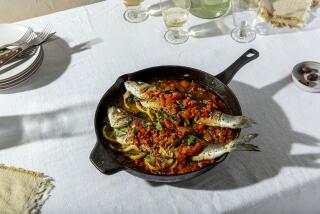Sonoma’s on to something
- Share via
LIKE most diet books, “The Sonoma Diet” -- by Connie Guttersen, a dietitian at the Culinary Institute of America in St. Helena, Calif. -- contains its fair share of cliche and hyperbole. Take Guttersen’s description of broccoli, one of her “power foods”: “It’s the Mr. Clean of vegetables, clearing away potentially carcinogenic toxins and even inhibiting tumor growth.”
Nonetheless, the diet follows what are generally considered the sound eating principles of the Mediterranean region, with an emphasis on healthful fats, fish, nuts, lean meats and whole grains. And it mirrors key aspects of “The South Beach Diet,” such as cutting back on white flour for life. The large selection of recipes are heavily influenced by the cuisine of Sonoma Wine Country, and the time it will take to prepare some of the recipes may scare off busy Americans.
On the other hand, dieters will be relieved to know that Guttersen allows for a daily glass of wine later in the program.
Perhaps the most likable facet of “The Sonoma Diet” is its simplicity. It contains three waves. In “Wave 1,” Guttersen encourages dieters to toss all high-carbohydrate foods. But this is not another low-carb diet that frowns on whole grains and some fruit. Instead, Guttersen believes dieters need to break their refined sugar and starch addictions before slowly bringing complex carbohydrates such as whole wheat bread back into the picture.
Once the sugar cycle is broken, the second wave brings some fruit, vegetables and whole grains back to the plate. The third wave is all about maintaining weight loss via a lifetime of good eating habits.
No diet book would be complete without power foods, and Guttersen posits 10, including grapes, olive oil and almonds. She dances around an in-depth discussion of exercise, just saying that it will speed weight loss.
Instead, “The Sonoma Diet” focuses on portion control. During a Wave 1 lunch, for example, dieters should fill a 9-inch dinner plate with 40% protein and 60% vegetables. To help follow the guidelines -- no heaping food 3 feet tall -- Guttersen provides a pullout card on what foods should be on the plates depending on the dieter’s wave or meal.
One problem with the book is that while it hints at some well-known studies, references to key articles are lacking. The diet is justified by a few anecdotes sprinkled throughout rather than statistical evidence about successful weight loss.
The eating habits of Sonoma seem to be working for the county’s residents, some of California’s slimmest, according to the 2001 state Department of Health Services report, “Prevalence of Obesity and Healthy Weight in California Counties.”
Only 13.8% of Sonoma’s population has a body mass index over 30, which is third best in the state and just behind Marin County at 10.9% and San Francisco County at 11.9%. Considering that 19.1% of Californians have a BMI higher than 30, Guttersen’s claim to a superior diet may have some validity.
Even if a dieter fails to lose much weight on the Sonoma Diet, the food is such an improvement over the junk most of us eat that the average American most likely will be healthier for following its principles.
*
Brett Levy, a systems analyst at The Times, regularly writes about obesity at www.dadtalk.net.


